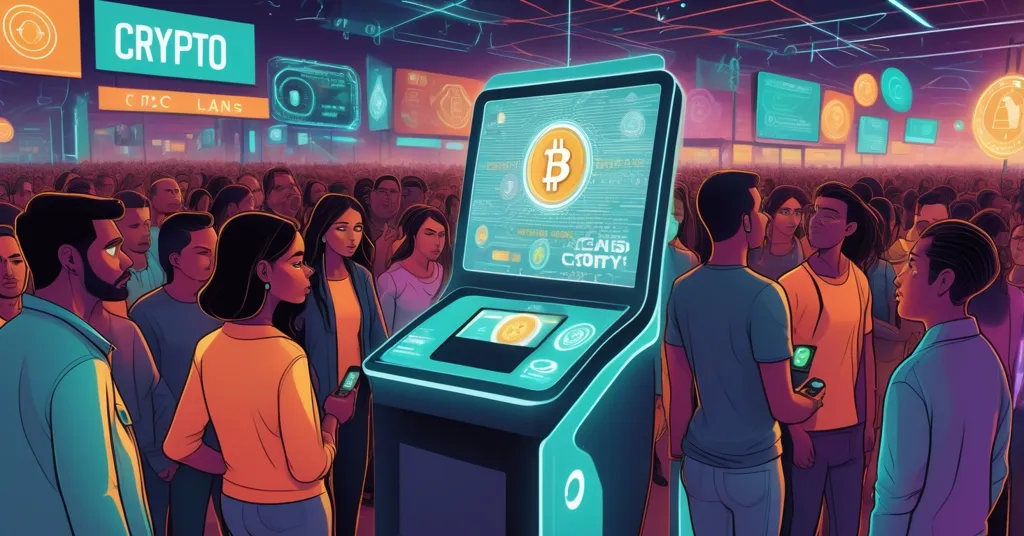Divine Research Issues 30,000 Unsecured Crypto Loans Using Iris-Scanning World ID

Crypto Lender Divine Rolls Out 30,000 Unsecured Loans with Iris-Scanning World ID
San Francisco-based crypto lender Divine Research has issued nearly 30,000 unsecured short-term loans worldwide since December, utilizing World ID—an iris-scanning identity verification system from Sam Altman’s Worldcoin—to authenticate borrowers. Targeting financially underserved individuals in inflation-battered economies like Argentina, Divine’s experiment in decentralized microfinance is both a beacon of hope and a lightning rod for concerns about privacy, risk, and sustainability in the volatile crypto lending space.
- Loan Milestone: Approximately 30,000 unsecured loans disbursed globally, typically under $1,000 in USDC.
- Tech Edge: World ID’s biometric iris-scanning tech prevents identity fraud in lending.
- Focus Market: Underserved populations in developing regions, with a pilot in hyperinflation-hit Argentina.
Divine’s Mission: Microfinance for the Forgotten
Divine Research is stepping into a gap that traditional banks have long ignored, offering small loans—mostly under $1,000—to people like high-school teachers and fruit vendors who scrape by in economies where a stable dollar is a distant dream. These loans are paid out in USDC, a stablecoin pegged to the U.S. dollar issued by Circle, ensuring borrowers aren’t crushed by the wild price swings often seen in cryptocurrencies like Bitcoin. For context, a stablecoin is a digital asset designed to maintain a fixed value, typically tied to a fiat currency like the dollar, making it a practical tool for everyday transactions or loans in volatile markets.
Argentina, where Divine is testing its model, is ground zero for financial desperation. With annual inflation soaring past 200% in recent years, the local peso loses value so fast that families struggle to afford basics like groceries or school supplies. A USDC loan isn’t just credit; it’s a lifeline to stability. Imagine Maria, a Buenos Aires teacher, borrowing $300 to buy classroom materials—without a bank account or credit history, Divine could be her only shot. Founder Diego Estevez frames this as a radical push for inclusion, as detailed in a recent report on Divine’s unsecured loan initiative:
“We’re loaning to average folks like high-school teachers, fruit vendors… basically anyone with access to the internet. This is microfinance on steroids.”
But let’s not get too misty-eyed. While the mission resonates with the ethos of decentralization and financial freedom we champion, the execution and risks demand a hard look.
World ID: Cutting-Edge Tech or Privacy Nightmare?
To tackle one of the biggest headaches in decentralized finance—identity fraud—Divine leans on World ID, a biometric system developed by Worldcoin, a project tied to OpenAI’s Sam Altman. Here’s how it works: borrowers have their irises scanned to create a unique digital identity, ensuring they can’t game the system by taking multiple loans under fake names. Worldcoin uses zero-knowledge proofs, a cryptographic method that verifies data (like proving you’re a unique person) without revealing the underlying details (like the iris scan itself). It’s like showing you have a key without handing it over. Worldcoin also claims to delete original scans after encryption and offers opt-outs, aiming to protect user privacy, as explained in this overview of biometric technology.
That sounds slick, right? A fraud-proof way to lend in a trustless space. But hold on—handing over something as personal as an iris scan for a $500 loan feels like signing away your soul for a latte. Critics point out that Worldcoin often targets low-income communities, where users might not fully grasp the privacy implications or data security risks, a concern echoed in discussions about privacy risks in crypto platforms. Past controversies, including scrutiny and bans in places like Kenya and parts of Europe, highlight shaky consent practices and weak regulatory oversight. If a data breach happens or a local government clamps down, Divine’s borrowers could be left exposed. Sure, biometrics are a bold step for effective accelerationism in disrupting outdated financial systems, but at what cost to personal sovereignty?
Risky Business: 40% Defaults and Echoes of Past Disasters
Now, let’s crunch some numbers, because they’re both staggering and sobering. Divine has pushed out around 30,000 loans in less than a year—a hell of a feat for a niche player. But here’s the kicker: first-time borrowers default at a rate of 40%. That’s not a glitch; it’s a crisis. Would you lend $500 knowing there’s almost a coin-flip chance of not seeing it back? To cover these losses, Divine slaps on fixed interest rates of 20-30%—a financial bear hug if I’ve ever seen one—and uses reclaimable Worldcoin tokens as a buffer. These tokens act like a refundable deposit, recoverable by Divine to offset unpaid loans. Meanwhile, the cash for lending comes from individual depositors chasing high yields, with Estevez swearing the math works out for everyone, as covered in an in-depth analysis of Divine’s lending model:
“We’ve engineered the system such that after accounting for default rates and the [interest] rates on offer, providers will always make a profit.”
I’m not buying the hype just yet. We’ve seen this movie before, and it doesn’t end well. Flashback to 2022, when crypto lending giants Celsius and Genesis imploded, leaving investors high and dry. Celsius’s CEO Alex Mashinsky got slapped with a 12-year prison sentence for fraud, while Genesis settled for $2 billion over investor scams. Those collapses exposed the ugly truth about unsecured lending and overblown promises of “guaranteed” returns, a pattern explored in a comparison of post-2022 lending revivals. Divine’s 40% default rate isn’t just a red flag; it’s a flashing neon billboard. Compared to traditional microfinance, where default rates often hover around 5-10%, this is a whole different beast. And while using USDC reduces volatility risks compared to the Bitcoin rollercoaster of yesteryear, and biometric checks cut down on fraud, there’s no hard data proving this model won’t crumble under a wave of defaults or a liquidity crunch.
Who are these depositors, anyway? Likely a mix of yield-hungry retail investors and crypto whales betting on big returns. But if defaults spiral, they’re the ones left holding the bag—just like Celsius’s victims. Divine’s reliance on high interest and token buffers flirts with the same dumpster fire that torched past lenders. We’re all for accelerating decentralized finance, but not if it means speeding off a cliff with depositors’ cash.
Argentina’s Crisis: Fertile Ground or Shaky Foundation?
Why Argentina? It’s not random. Hyperinflation has gutted the peso, pushing small businesses and families to the brink. A fruit vendor might earn pesos worth $50 one week and $30 the next for the same work. Stablecoin credit like USDC offers a way to buy inventory or pay bills without watching savings evaporate. Divine’s focus here taps into a broader trend: crypto adoption often spikes in regions where fiat currency fails. It’s a real-world test of decentralization’s promise to bypass corrupt or broken banking systems, a strategy dissected in this detailed look at Divine’s operations in Argentina.
Yet, there’s a flip side. Argentina’s government has a history of cracking down on dollar alternatives to prop up the peso—USDC loans could easily draw scrutiny as undermining national monetary policy. Look at India’s harsh crypto taxes or outright bans elsewhere; regulatory whiplash isn’t just possible, it’s probable. Divine might be empowering the unbanked today, only to face a ban tomorrow if local authorities deem it a threat. That’s a gamble for both borrowers and depositors, a concern amplified by risks of crypto lending in developing economies.
The Bigger Picture: Crypto Lending’s Tentative Revival
Divine isn’t the only outfit trying to resurrect unsecured lending from the ashes of 2022. Competitors like 3Jane, backed by venture firm Paradigm, are issuing uncollateralized USDC loans on the Ethereum blockchain, using proof of assets—verifying financial holdings via blockchain records without collateral—and AI-powered lending agents to manage risk. Another player, Wildcat, focuses on custom terms for trading firms, with advisers noting direct coordination for recourse during defaults. Meanwhile, Wall Street giants like Cantor Fitzgerald dip toes into Bitcoin-backed financing, and heavyweights like Coinbase and Tether dominate safer, collateralized lending in a multi-billion-dollar market. Even JPMorgan Chase is sniffing around crypto-backed loans, signaling cautious institutional interest.
Divine stands out with its microfinance angle and biometric twist, but it’s a minnow in a shark tank. Unsecured lending remains a tiny niche, haunted by past scams and skepticism. From a Bitcoin maximalist lens, I’ll grumble that USDC—a centralized stablecoin—takes center stage over BTC. Bitcoin is the ultimate symbol of financial sovereignty, a middle finger to centralized control. But let’s be pragmatic: BTC’s price volatility makes it a lousy fit for microloans where borrowers need stability. Stablecoins fill a niche Bitcoin shouldn’t, ensuring a $300 loan doesn’t balloon or crash overnight. Still, I’d wager Bitcoin could play a role in future models—perhaps via off-chain solutions like the Lightning Network for low-fee, stable transactions, or as collateral for depositors. If Wall Street’s creeping in, BTC’s clout could yet shine in lending.
Regulatory and Ethical Minefields Loom Large
Beyond defaults, Divine faces a gauntlet of other risks. Regulatory uncertainty is a big one. Crypto lending lacks clear global frameworks, and biometric data in finance could draw heat from the U.S., EU, or even Argentina if seen as skirting local laws. World ID’s track record doesn’t help—bans in Kenya and probes in Europe over consent and data practices signal potential blowback, a topic hotly debated in community discussions on Argentina’s crypto landscape. If Divine’s model hinges on iris scans and a government pulls the plug, what’s Plan B?
Then there’s the ethical quagmire. Worldcoin’s recruitment often targets vulnerable populations, offering small crypto payouts for scans. Do borrowers in dire straits truly understand data retention or security risks? If a hack exposes biometric info, there’s no undoing that damage. Divine might not directly control World ID, but guilt by association could tank trust, especially given the security concerns surrounding World ID technology. We champion privacy and freedom, so any system exploiting personal data under the guise of inclusion gets a hard pass. Innovation shouldn’t mean selling your eyeball to the highest bidder.
Key Takeaways and Questions to Ponder
- What sets Divine Research apart in the crypto lending game?
Divine focuses on unsecured microloans under $1,000 in USDC for underserved global borrowers, using World ID’s iris-scanning tech to curb fraud—unlike the collateral-driven giants like Coinbase. - How does Divine cope with a staggering 40% default rate?
They offset losses with 20-30% interest rates and reclaimable Worldcoin tokens, promising depositors profits via high yields, though long-term viability is untested. - Why target Argentina for this lending experiment?
Hyperinflation over 200% yearly devastates the peso, creating urgent demand for stable, dollar-pegged credit like USDC, making it a prime testing ground for alternative finance. - Is World ID’s biometric tech a privacy time bomb?
Quite possibly—Worldcoin claims data protection, but shaky consent practices and past bans in regions like Kenya raise risks for vulnerable users, which could backfire on Divine. - Can Divine dodge the ghosts of Celsius and Genesis collapses?
Biometric checks and stablecoin use are improvements, but a 40% default rate and depositor reliance mirror past flaws—only time will reveal if lessons were learned. - Could Bitcoin play a role in microfinance lending models?
Not directly for loans due to volatility, but as collateral or via solutions like Lightning Network for low-fee transactions, BTC could align microfinance with decentralization’s core values.
Divine Research earns props for a ballsy experiment that could genuinely uplift the unbanked, embodying the spirit of decentralization and effective accelerationism we root for in disrupting broken financial systems. Using World ID to tackle fraud in lending is the kind of forward-thinking push we need. But let’s not chug the optimism straight from the bottle. A 40% default rate, unproven sustainability, privacy landmines with biometric data, and looming regulatory storms cast serious doubt. This isn’t a blind cheer for Divine or a cynical burial—it’s a nudge to watch with hawk eyes and think critically. The path to mass adoption of decentralized finance is littered with bold trials like this, but only those balancing audacity with accountability will endure. We’re here for the revolution, not the wreckage.



